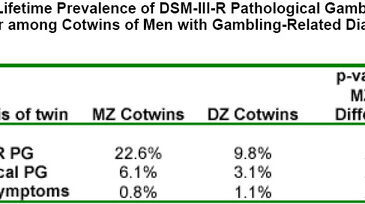Twin registries are valuable resources that provide investigators with a pre-assembled, tracked sample of research subjects. Among the best-known is the Vietnam Era Twin Registry (VETR), a national sample of male twins who served in the Vietnam War. Slutske, Eisen, True, Lyons, Goldberg, Tsuang (2000) used the VETR to investigate the common genetic vulnerability for pathological gambling and alcohol dependence.
Studying twins is one of the most common ways to evaluate the role of genetics in the development of a particular disorder. In particular, studying monozygotic twins allows researchers to evaluated the relative etiological contributions of genetics and the environment. Since monozygotic ("identical") twins are born with exactly the same genotype, any variations in phenotype between the two can generally be attributed to non-shared environmental factors.
Slustke et al. contacted 3372 twin pairs and administered an instrument based on the DSM-III-R criteria for pathological gambling disorder. Of the 6744 individuals interviewed, the lifetime prevalence of pathological gambling was 1.4%, while the lifetime prevalence of subclinical pathological gambling was 6.2%. The lifetime prevalences among both monozygotic and dizygotic cotwins of subjects with various gambling-related diagnoses are presented in table 1.
As indicated in table 1, monozygotic cotwins of men with clinical and subclinical pathological gambling disorder were not significantly more likely to meet diagnostic criteria than dizygotic cotwins of men with clinical and sub-clinical pathological gambling disorder. These findings alone do not provide sufficient support for a genetically-based etiology for pathological gambling. However, other findings presented elsewhere in the paper still provide evidence for the genetic hypothesis. These findings will be discussed in future WAGERs.
References
Slutske, W.S., Eisen S., True, W.R., Lyons, M.J., Goldberg, J., & Tsuang, M. (2000). Common genetic vulnerability for pathological gambling and alcohol dependence in men. Archives of General Psychiatry, 57, 666-673.





